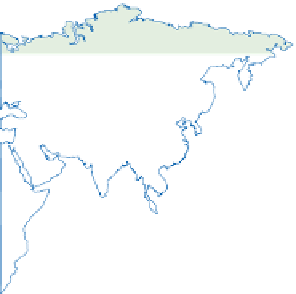Geoscience Reference
In-Depth Information
LONGITUDE
Figure 11.8
Ocean surface
temperature.
Source: Adapted from Summerhayes
and Thorpe (1996)
60°
120°
180°
120°
60°
0°
80°
80°
60°
60°
40°
15°C
40°
15°C
20°
20°
25°C
0°
0°
20°
20°
25°C
40°
40°
1
5°C
60°
5°C
60°
180°
60°
120°
120°
60°
0°
Solar radiation flux at the ocean surface strongly
influences the upper 100-200 m, which has a temperature
diurnally or seasonally in this layer but they are susceptible
to turbulent mixing by wind and ocean surface currents.
The main
thermocline
is the zone of steepest temperature
gradient between 100 m and 500 m, at rates of 0·4-0·7
C
per 10 m depth. Turbulent heat exchange is not felt below
the thermocline, and ocean water assumes its stable mean
temperature of -1
Salinity
The common expression of solute content is
salinity
,or
the quantity of solutes in parts per thousand (‰) by
weight and irrespective of composition. NaCl (sodium
chloride) is by far the commonest species at over 90 per
cent by mass and thus the principal constituent of
brine
or 'salt water'. Global surface values range from about one
part per thousand in freshwater estuaries to a normal
ocean range between 32 and 37·5 parts per thousand. In
general, saline water is found at depth, owing to its greater
density below a
halocline
isolating less saline surface
waters (
Figure 11.9
).
The halocline may coincide with the
pycnocline
, or zone of greatest density increase (
Figure
or negative water flux with the rest of the hydrological
cycle through strong evaporation, low rainfall or low
freshwater influx. This raises average salinity to 38 parts
per thousand in the Mediterranean, 40 parts per thousand
in the Red Sea and staggering values of over 350 parts per
thousand at depth through density settling in the latter.
The global bulk average salinity of 34·5 parts per thousand
is approached below the
thermocline
(see below) where
surface heating effects are negligible.
C. This prevents general
thermal mixing with deep water because the surface layer
is warmer and therefore more buoyant. It is important
to note that different combinations of temperature
and salinity can produce the same density/water mass
characteristic but modest changes in salinity have a greater
impact on density than modest changes in temperature.
Temperature ultimately controls the pycnocline because
ocean temperature range greatly exceeds salinity range.
By comparison with surface solar heating, geothermal
heat flow through oceanic crust contributes little to the
thermal balance of the oceans; not even heat concentra-
tion at mid-ocean ridges has any measurable effect on
ocean circulation patterns. Solar irradiation has two other
significant effects. The importance of stored heat is
discussed at the end of this chapter. Light penetrates only
to shallow depths, owing to high attenuation by sea water.
Ocean colour typically varies from a surface blue colour
(light scattering) through a green hue (chlorophyll-rich
C to +5
Temperature and structure
Oceans exhibit both thermal and density
stratification
or
layering, based respectively on temperature and salinity.































































































































































































































